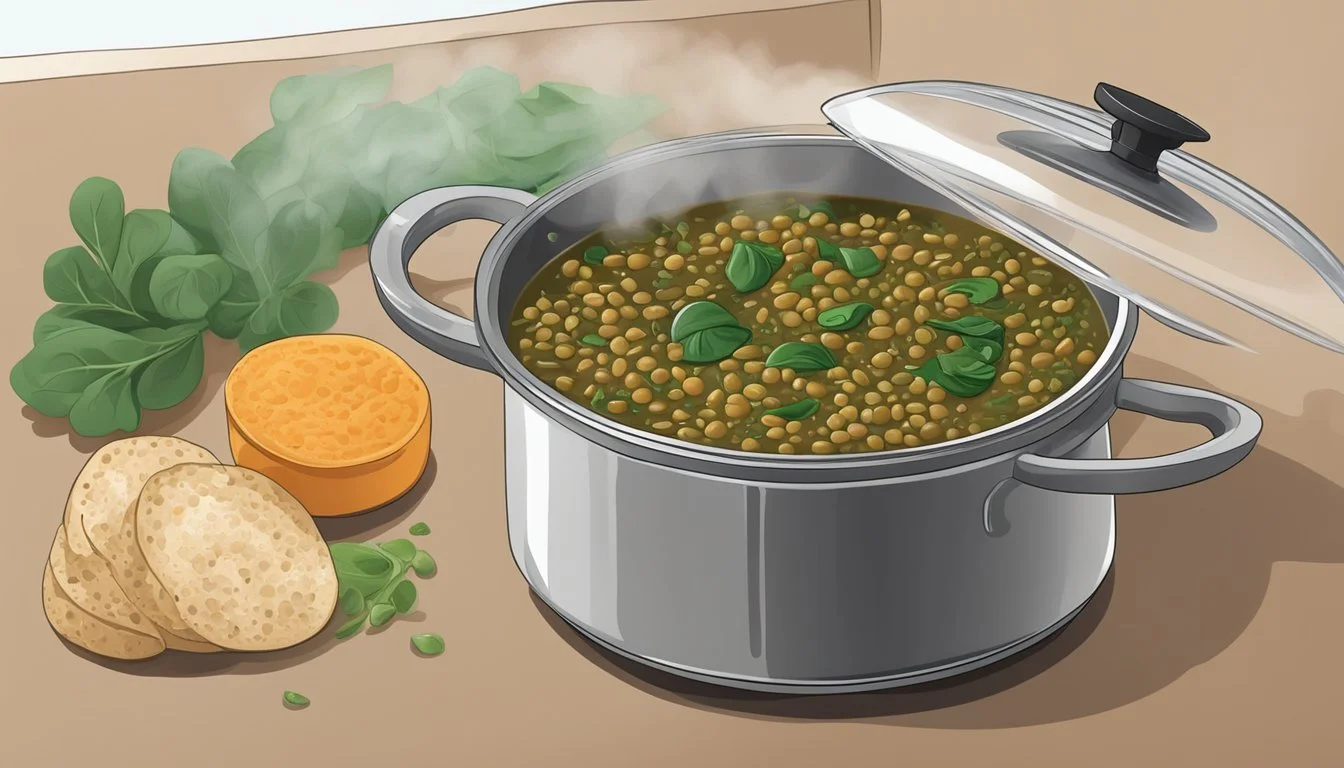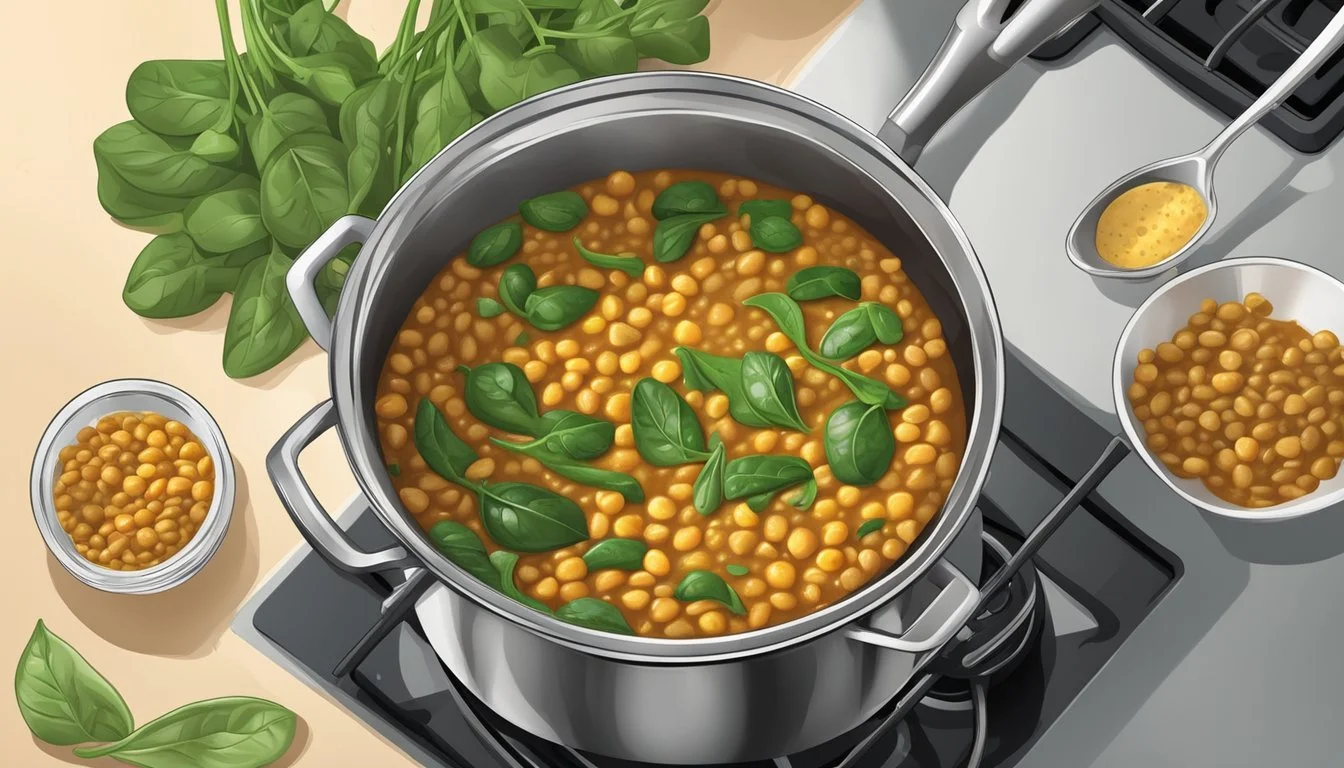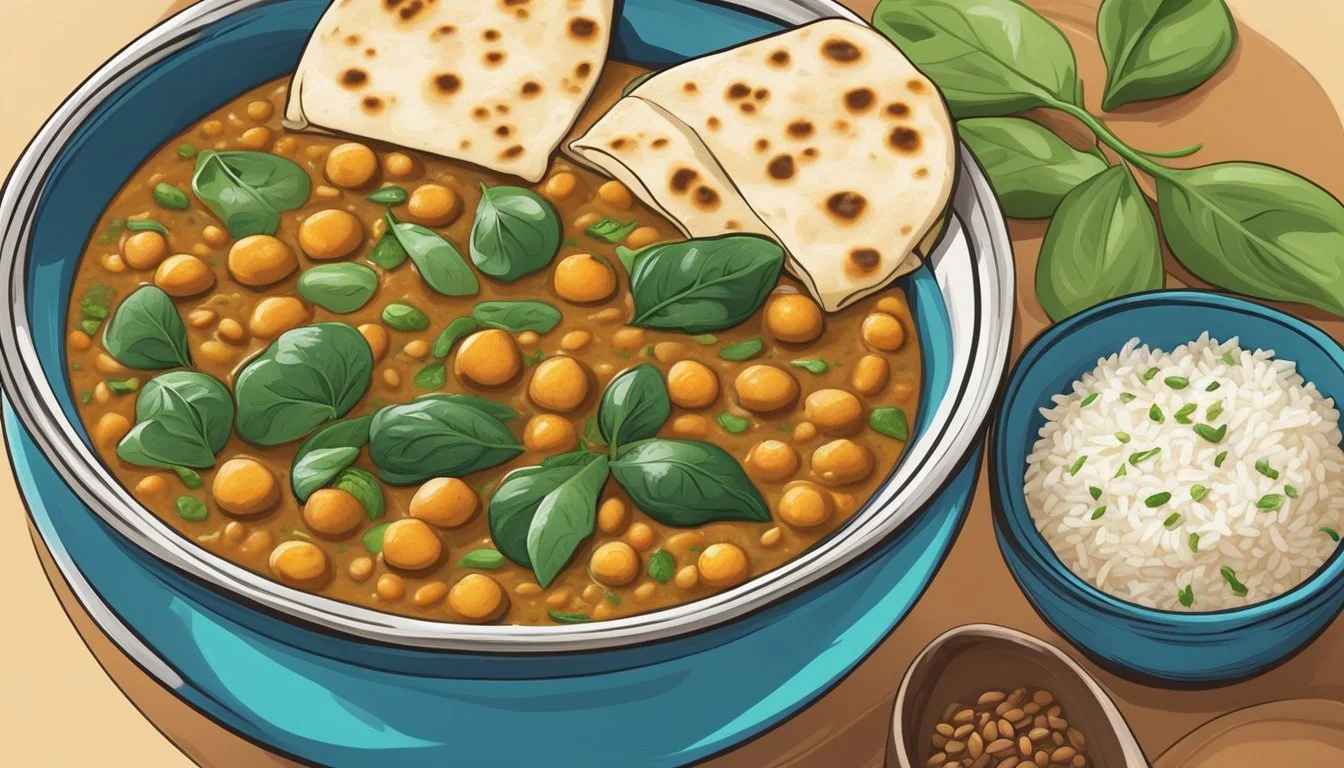Best Way to Reheat Lentil and Spinach Curry
Ensuring Flavorful Leftovers
Lentil and spinach curry, a nutritious and flavorful dish, often leaves home chefs pondering over the ideal method to reheat it without losing its robust flavors and delicate textures. Preserving the integrity of this dish when reheating ensures that its aromatic blend of spices, the creaminess of lentils, and the freshness of spinach remain intact. The way heat is applied to this composite dish can make the difference between a just-okay leftover meal and a reheated curry that rivals its freshly cooked state.
The best approach to reheating lentil and spinach curry involves gentle and even heat application. Direct, intense heat can cause the breakdown of the delicate spinach and the lentils may become too soft or mushy, adversely affecting the texture of the curry. To achieve the most satisfying results, one must consider methods that do not radically alter the moisture content or cause the spices to become muted. It is crucial to use methods that evenly warm the curry to a pleasant eating temperature without overcooking any of the individual ingredients.
Oven reheating emerges as a preferred method to maintain the balance of flavors and textures in lentil and spinach curry. Heating slowly in a covered oven-safe dish at a moderate temperature allows for the warmth to permeate through the curry gradually. This technique ensures that the lentils are adequately heated without drying out and that the spinach doesn't wilt excessively from the heat, thereby preserving the dish's overall texture and flavor.
The Importance of Safe Reheating Practices
Reheating lentil and spinach curry properly is not only a matter of preserving its flavors but also about ensuring the meal is safe to eat. These practices are crucial to preventing bacterial growth that can lead to foodborne illnesses.
Understanding Food Safety
Safe reheating techniques involve heating the curry to an internal temperature high enough to kill potential bacteria. Bacillus cereus, for example, is a type of bacteria that is commonly found in foods like lentils and rice. This bacterium can survive some cooking processes and is known for its ability to quickly multiply at room temperature.
To ensure food safety:
Always reheat food until it is steaming hot throughout.
Use a food thermometer to check that the curry reaches an internal temperature of at least 165°F (74°C).
Preventing Foodborne Illnesses
Foodborne illnesses can be caused by contaminants or the proliferation of bacteria due to improper food handling. Food poisoning is often associated with eating food not heated thoroughly or stored at the wrong temperature.
Key points to remember:
Prevent contamination by reheating the curry in a clean environment using clean utensils.
Avoid bacterial growth by reheating only the portion of curry intended for immediate consumption.
Do not allow the curry to sit at room temperature for more than two hours.
Utilizing these practices when reheating lentil and spinach curry can minimize the risk of foodborne illnesses and ensure a safe, enjoyable meal.
Preparing to Reheat Lentil and Spinach Curry
Proper preparation is essential for successfully reheating lentil and spinach curry, ensuring that its flavors and textures are preserved. Two crucial steps involve thawing frozen leftovers and bringing the curry to room temperature before reheating.
Thawing and Defrosting Leftovers
If the lentil and spinach curry has been kept in the freezer, it must be defrosted safely to maintain quality. For optimal results:
Transfer from Freezer to Fridge: Move the container of leftover curry from the freezer to the refrigerator. This gradual thawing method can take up to 24 hours, depending on the quantity.
Water Bath: For a quicker defrost, place the sealed container of curry in a cold water bath. Change the water every 30 minutes to continue the thawing process safely.
Note: Avoid using a microwave for defrosting as it can partially cook the lentils, affecting their texture.
Bringing Curry to Room Temperature
Before reheating, the thawed curry should be brought to room temperature to ensure even warming. Follow this simple step:
Let the thawed curry sit on the counter for about 15 minutes. This transition reduces temperature shock and promotes uniform heating throughout the dish.
By following these preparation steps, one can ensure that the lentil and spinach curry is reheated carefully, maintaining its wholesome flavors and the integrity of its delicate ingredients.
Choosing the Right Reheating Method
To best preserve the flavors and textures of lentil and spinach curry when reheating, selecting the appropriate method is vital. This section explores microwave, oven, and stovetop techniques tailored for such dishes.
Microwave Reheating Technique
Reheating lentil and spinach curry in a microwave is a quick and efficient option. For best results, they should transfer the curry into a microwave-safe bowl, adding a small amount of water or stock to keep the dish moist. It is important to cover the bowl with a microwave-safe lid or a damp paper towel to retain moisture. They must reheat the dish in 30-second intervals, stirring in-between to ensure even heat distribution.
Oven Reheating Strategy
Oven reheating is suitable for larger portions and can evenly reheat without causing the lentils to dry out. The individual will preheat the oven to 350°F (180°C), place the curry in an oven-safe dish with a bit of water or stock, and cover it with foil or a lid to retain moisture. The curry should stay in the oven for about 15-20 minutes, and they are advised to stir occasionally for uniform warmth.
Stovetop Reheating Process
Stovetop reheating allows for greater control over the reheating process, maintaining the curry's consistency and preventing it from becoming too thick. The person reheating the dish should pour it into a saucepan and warm it on the stove over medium heat. Continuous stirring is recommended to promote even heating and to avoid burning the bottom. If the curry appears too dense, additional liquid can be incorporated to achieve the desired consistency.
Step-by-Step Guides to Reheating Curry
To retain the wholesome flavors of lentil and spinach curry when reheating, one must consider the method that best preserves moisture, prevents separation, and evenly distributes heat. Whether using a microwave, oven, or stove, careful attention to temperature and gentle stirring is essential to maintain the curry’s quality.
Reheating Curry in the Microwave
Container: Place the curry in a microwave-safe container.
Moisture: Add a tablespoon of water or broth to keep it moist.
Cover: Loosely cover the container with a microwave-safe lid or plastic wrap to trap steam.
Power and Time: Set the microwave to medium power and heat in 30-second intervals.
Stirring: Stir the curry between intervals to ensure even reheating.
Final Check: The curry is ready when it is heated thoroughly to at least 165°F for food safety.
Reheating Curry in the Oven
Preheat: Preheat the oven to 350°F (180°C).
Oven-Safe Dish: Transfer the curry into an oven-safe dish.
Extra Liquid: Stir in a bit of water or stock if the curry seems too thick.
Covering: Securely cover the dish with aluminum foil or a lid.
Baking Time: Heat it for 15-20 minutes, stirring halfway through.
Temperature Check: Ensure the internal temperature reaches 165°F.
Reheating Curry on the Stove
Pan: Choose a heavy-bottomed pan or skillet.
Low Heat: Start at a low heat to prevent burning.
Stirring: Frequently stir, watching for even heating and preventing sticking.
Lid: If available, use a lid to cover the pan for part of the time to conserve moisture.
Consistency Adjustments: Add a splash of water or broth if the curry is too thick.
Temperature Check: Heat until the curry reaches a temperature of 165°F, signaling that it’s ready to be served.
Note: If reheating rice as an accompaniment, always ensure it's stored properly before reheating to prevent bacterial growth and check that it reaches the same safe internal temperature of 165°F.
Maintaining the Flavor and Texture of the Curry
When reheating lentil and spinach curry, one must carefully manage spices, liquids, and heating to maintain the integrity of its flavors and texture.
Adjusting Spices and Seasonings
Over time, the spices in a lentil and spinach curry can lose their potency. To ensure the reheated curry retains its distinct taste, one should assess and adjust the seasoning. A pinch of salt can amplify the existing flavors, while a dash of lemon juice may enhance the curry's freshness. If the original spice blend has mellowed, reintroducing ground spices such as cumin or coriander could help in restoring the dish's vibrancy.
Managing Curry Liquids and Creams
The consistency of lentil and spinach curry is pivotal to its enjoyment. If the curry seems too thick, adding a small amount of water or broth can help achieve the desired viscosity. For creams such as yogurt, it is preferable to stir them into the curry after reheating to avoid separation. To enrich the dish's creaminess without overwhelming it, consider incorporating a tablespoon of yogurt or coconut milk.
Avoiding Overheating
Reheating curry should be done gently to preserve its texture and prevent the spinach from becoming overly wilted. It is essential to avoid high heat as it can lead to a breakdown of the lentils and cause the curry to become mushy. Gently warming the curry over low heat, stirring occasionally, ensures even reheating while maintaining its robust texture. Microwave reheating, if used, should be at a medium power with regular stirring to distribute heat without causing the flavors to dissipate.
Additional Curry Reheating Tips
Reheating a lentil and spinach curry properly is essential to maintain its rich flavors and nutrients. Below are focused tips to ensure the curry is warmed efficiently and the accompaniments retain their freshness.
Using Appropriate Reheating Equipment
Choosing the right equipment is pivotal for preserving the curry's quality. A microwave-safe container with a lid is ideal for microwave reheating, while an oven-safe dish works best for oven methods. For the stovetop, a heavy-bottomed pan promotes even heat distribution and prevents the lentils from sticking.
Ensuring Even Heat Distribution
For even reheating, frequently stir the curry to distribute the warmth throughout. In the oven, a baking sheet can be used underneath the dish for uniform heat. When using a microwave, pausing and stirring the curry at intervals helps in achieving an even heat distribution.
Making Accompaniments Taste Fresh
Naan bread can be refreshed in the oven, wrapped in foil on a baking sheet, which prevents drying out. To rejuvenate the flavors of accompaniments like rice or flatbreads, sprinkle water before heating. Adding fresh herbs just before serving can enhance the flavor profile and revive the essence of the dish.
Curry Storage Recommendations for Optimal Reheating
To ensure that lentil and spinach curry retains its wholesome flavors when reheated, proper storage is critical. This not only affects taste and safety but also the ease of reheating.
Best Practices for Storing Curry
When storing curry, it's important to allow it to cool down before placing it in the refrigerator. The curry should reach room temperature within two hours to prevent bacterial growth. Storing curry properly involves the use of airtight containers to keep out moisture and other contaminants. Glass containers are preferred as they don't retain odors and are easy to clean.
Cooling: Allow curry to cool at room temperature for no more than two hours.
Containers: Transfer to airtight glass containers.
Wrapping: Optionally, cover the surface with a piece of plastic wrap before sealing.
Fridge Temperature: Ensure the refrigerator is at 4°C (39°F) or below.
Labeling: Mark the container with the date of storage to track freshness.
Transferring Leftovers for Reheating
When transferring leftovers for reheating, it's best to portion out only as much as will be consumed in one sitting. This minimizes temperature fluctuations for the remaining curry, preserving its quality.
Portioning: Separate into single-serving sizes to avoid repeated reheating.
Utensils: Use clean utensils to prevent cross-contamination.
Transfer: Move the portion to be reheated into another container if not using microwave-safe storage containers.
By adhering to these recommendations, one can maintain the integrity and flavor of lentil and spinach curry during storage and subsequent reheating.
Understanding Different Types of Curry Reheating
When reheating curry, one must consider the type of curry and its ingredients to preserve the flavors and textures. Specific techniques are recommended for vegetable-based curries, meat curries, and takeaway curries to achieve the best results.
Vegetable Curry Considerations
Lentil and spinach curry, a typical vegetable-based dish, requires gentle reheating to maintain its wholesome flavors. Here's a quick guide:
Oven Reheating:
Preheat to 350°F (175°C).
Add a little water if the curry appears dry.
Cover the dish with foil and heat for about 15-20 minutes, stirring occasionally.
Stovetop Reheating:
Use a low to medium heat.
Occasionally stir to distribute heat evenly without damaging the vegetables’ texture.
Vegetables such as spinach in the curry are sensitive to overcooking, so swift reheating is vital to preserve their integrity and nutritional content.
Meat-Based Curry Reheating
For curries with meats like chicken, prawn, or pork, internal temperature is a key safety concern. The goal is to avoid overcooking while ensuring it's heated thoroughly:
Reheat to an internal temperature of 165°F (74°C).
Prawn Curry:
Heat until prawns reach 145°F (63°C).
Pork Curry:
Aim for an internal temperature of 145°F (63°C).
Whether using an oven or on the stovetop, adding a bit of water or stock can help to prevent the meat from drying out.
Takeaway Curry Reheating
Takeaway or leftover curries may have cooled and absorbed additional moisture, affecting texture and flavor:
Microwave Reheating:
Heat in intervals, stirring in-between to promote even warming.
Frozen Curry:
Thaw it completely before reheating to ensure even temperature distribution.
Incorporating fresh spices such as garlic or ginger during the reheating process can help to revitalize the flavor profile of Indian cuisine without overpowering the original tastes.
Conclusion: Serving Suggestions and Final Thoughts
When serving reheated lentil and spinach curry, presentation and accompaniments are as crucial as the reheating process itself. A bowl of this hearty, aromatic curry warrants a garnish of fresh cilantro to enhance its visual appeal and add a burst of fresh flavor. This herb complements the spices well and gives a refreshing contrast to the warm dish.
Here are some serving suggestions for optimal enjoyment:
Pair the curry with a side of basmati rice or naan bread to soak up the delicious sauce.
For a healthier option, a bed of brown rice or quinoa can be a great alternative.
A dollop of yogurt or a squeeze of lemon juice can be used to add a touch of creaminess or acidity, which can brighten the dish.
In summary, to maximize the flavors of lentil and spinach curry when reheated, it should be served hot with recommended accompaniments. This not only makes the dish more satisfying but also ensures that the intricate layers of flavor are fully appreciated. Garnishing with cilantro not only adds a pop of color but also contributes to the overall taste profile of the curry.






